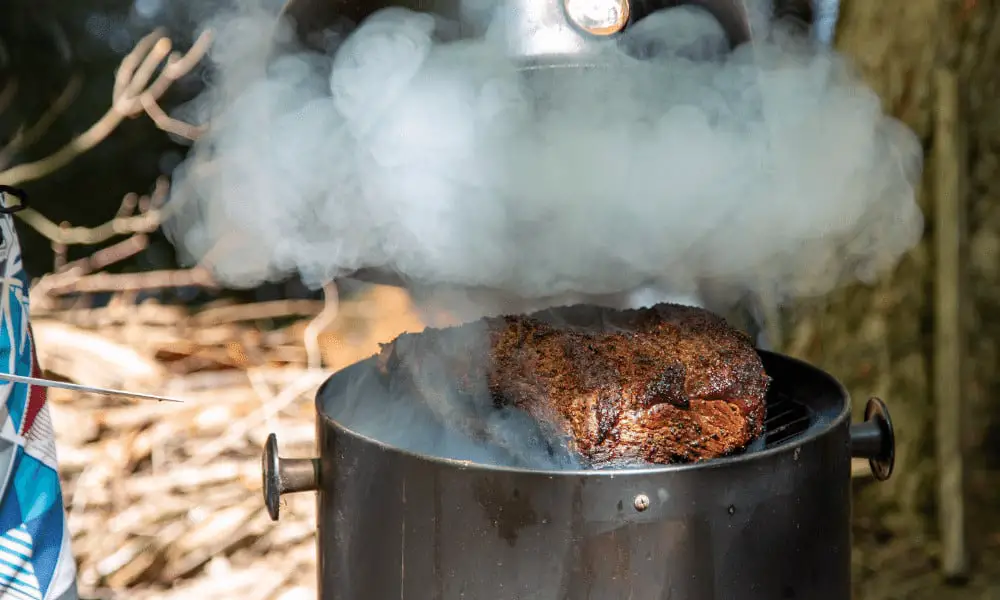Brisket is the ultimate meat that really showcases how intricate the smoking process really is. If you’ve smoked brisket before, you’ll know just how temperamental it can be. But, once you’ve smoked brisket enough, you really do get the hang of it, and understand what is actually going on at each stage of the cook.
I don’t know which problem is better to have, a brisket that’s taking too long to cook, or a brisket that’s cooking too quickly. Either way, you have all the tools at your disposal to manipulate the process and end up with a masterpiece.
Here’s a master guide for everything you need to do if your brisket is cooking too fast.
Brisket Cooking Too Fast
If you’ve noticed your brisket is cooking too fast and the temperature is rising too quickly, don’t panic. There are several things you can do to ensure it stays moist, juicy, and absorbs enough smoky flavor before it’s ready.
It’s also important to note that the rise in brisket temperature is not consistent throughout the cook, as your brisket will hit a stall at between 150-170°F where the cooking of your brisket will dramatically slow down.
This is vital knowledge, as it may appear your brisket is going to be done too early, but really it hasn’t even hit the stall which can add hours to your smoke.
Nonetheless, if it’s apparent that your brisket is cooking too fast, there are three main actions you can take to slow it down, keep the smoke rolling, and create a juicy and sensational masterpiece.
- Spritz More Often
- Turn Temperature Down
- Don’t Wrap Through The Stall
A Quick Brisket Philosophy

A brisket that cooks too quickly can lead to some major problems in texture and taste. As you’ll know brisket requires low and slow cooking in order for all the connective tissue and fat to effectively melt, turning a naturally tough cut of beef, tender.
If your brisket cooks at too high temperatures or for not long enough, then this connective tissue will remain intact and you’ll be left with one very tough brisket. So, one of the most important principles to adhere to is cook to tenderness, not time or temperature.
That being said, a good aim to take is pulling the brisket off the smoker at 200-205°F internal temperature, as this is a good indication that it’s reached a high enough temperature for the breaking down process to occur.
But, if it’s still not as tender as you’d like it, you can push onwards at a low temperature to continue the process. Just be aware, you don’t want to cook it for too long past 205°F, otherwise you risk your brisket losing texture and falling apart.
How To Slow Down The Cooking Of Your Brisket
So, because of how brisket cooks, even if your brisket is cooking quickly, you can simply keep it going until it reaches your desired tenderness, even if it reaches up to 210°F
However, there’s a few good reasons you want to cook the brisket more steadily. It helps develop an even texture, build up a solid bark, and develop a strong smoke ring on your brisket.
So, if you’re monitoring the internal temperature of your brisket and have noticed it’s rising a bit quickly for your liking, then here are the best three actions you can take.
Spritz More Often

If you’ve been around the backyard, you’ll know just what magic spritzing can really do when you’re smoking meat. It’s an opportunity to add humidity to your meat, keeping it moist. It allows you to build up another layer of flavor, depending on what you spritz your brisket with. Plus, it actually allows more smoke flavor and bark to build up.
Although the downside of spritzing in some cases is that it let’s the temperature drop inside your smoker as you have to lift the hood, you can actually use this to your advantage if your brisket is cooking too fast.
Instead of spritzing every 90 minutes, if your brisket is cooking too fast then spritz every hour or even 45 minutes. This will allow you to hold the temperature of your brisket steady, all while developing a stronger flavored bark on your meat.
Turn The Temperature Down
It’s always best to try to keep the temperature consistent throughout the cook. This helps the meat cook much more evenly, reducing the chances of the brisket drying out.
Keeping the temperature consistent also helps deliver a consistent smoke, rather than risking any dirty smoke, or no smoke at all depending on how you’re cooking your brisket!
But, if you keep the temperature too high it’s possible for the brisket to completely miss the stall.
This stall process is actually vital, as it allows sufficient time for the brisket’s fat and connective tissue to break down properly!
If things are cooking much too quickly then it’s worth simply turning down the temperature.
Whether you’re using a pellet grill, charcoal smoker, or electric smoker, reducing the temperature to 225°F will certainly slow down the cooking process, and is essential when you’re smoking smaller briskets.
Don’t Wrap Through The Stall
Ahh the stall. We’ve all had it, we’ve all hated it, and we’ve all learnt to live with it.
The stall is simply the phenomenon that happens when you’re smoking meat, particularly brisket, where the brisket begins to cool by evaporative cooling quicker than the temperature in the smoker can push through.
To combat this, most experienced pitmasters will wrap their brisket in butcher’s paper or foil to stop this cooling effect from taking place, locking in all the heat and moisture. But, if your brisket has reached the stall, or began to push through it too quickly, then one tactic you can use is actually to ride it out, without wrapping your brisket at all!
This can have it’s risks, as your brisket may end up taking additional hours to cook. But it can have its benefits too. Not only will it keep the brisket cooking at a steady temperature, breaking down the connective tissue and fat, but it will also build a super tasty and deliciously smoky bark.
If you’re becoming impatient you can easily wrap it at a later stage too!
Keeping A Brisket Warm If It’s Cooked Too Fast
So, in the end you may have been reading this master guide too late in the process, and now your brisket has already hit 205-210°F. Don’t panic, there are still a few things you can do to keep it going without overcooking your brisket.
- Rest it for up to 8 hours in a cooler, wrapped in a towel. This is called the “Faux Cambro” method, where you can hold the brisket at safe temperatures for an extended period of time wrapped in a towel in a closed cooler to keep all the heat in.
- Rest it on low in the oven. Place your brisket in the center of the oven at as low as 170°F. This will inevitably keep cooking your brisket, but at a very low pace so it can stay warm for hours ahead of serving. This is a great way to keep it warm while serving brisket to large crowds too!
For full details check out what to do if your brisket is done too early.
Final Thoughts
So, a brisket that’s cooking too fast isn’t the worst problem to have as there are several tools in your arsenal you can use to slow down the cooking process.
Spritzing more often, turning the temperature down, or forgoing the wrapping process are all excellent ways to manipulate the cooking time or your brisket, retaining it’s moisture and deliciousness levels.
If your brisket does come out tough, the best advice is to simply learn from it. Your 100th brisket will always be better than your 10th, that’s just the learning process of good, traditional barbecue.


